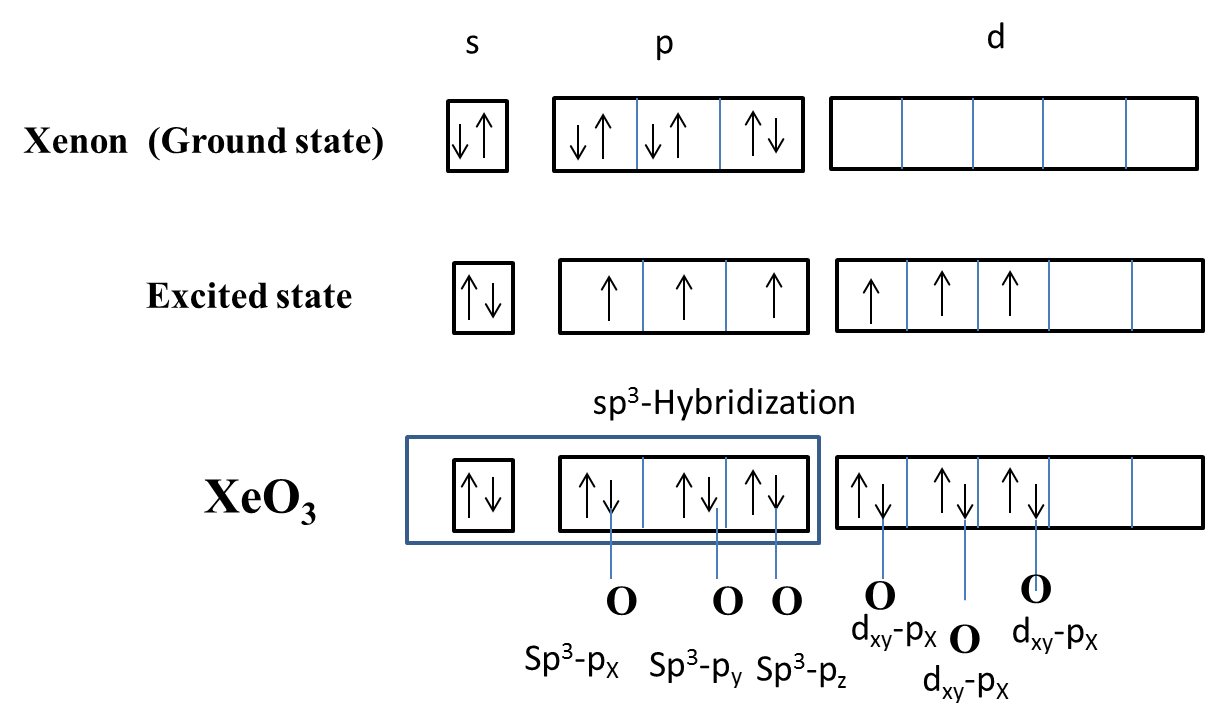
Answer
453.6k+ views
Hint: Xenon forms two types of oxides. They are xenon trioxide and xenon tetroxide. The hybridization of xenon trioxide ($Xe{{O}_{3}}$ ) is $s{{p}^{3}}$ ). We have to draw an orbital diagram to know the overlapping of orbitals in the formation of xenon trioxide.
Complete answer:
- In the question it is asked to find which overlapping among the given options is not present in the xenon trioxide.
- Xenon belongs to group VIII A in the periodic table.
- Oxygen belongs to group VI A in the periodic table.
- The orbital overlapping and hybridization of the oxygen atoms with the xenon atom is as follows.

- From the above picture we can say that $s{{p}^{3}}+{{p}_{x}}$ , $s{{p}^{3}}+{{p}_{y}}$ and $s{{p}^{3}}+{{p}_{z}}$ are involved in the hybridization of xenon trioxide.
- Coming to option C, ${{d}_{xz}}+{{p}_{x}}$ is also involved in the hybridization process of xenon trioxide.
- We cannot see any $s{{p}^{3}}+s$ type of overlapping in the hybridization of the xenon trioxide.
- Therefore $s{{p}^{3}}+s$ type of overlapping is not present in xenon trioxide.
So, the correct option is D.
Note:
Xenon belongs to inert gases. Generally inert gases won’t react with other molecules. But in extreme conditions they react and form few derivatives as the products. Oxides of xenon belong to that category. The structure of xenon trioxide is trigonal pyramidal. In the structure of xenon trioxide there are three sigma bonds and three pi bonds. The oxidation state of xenon in xenon trioxide is ‘+6’.
Complete answer:
- In the question it is asked to find which overlapping among the given options is not present in the xenon trioxide.
- Xenon belongs to group VIII A in the periodic table.
- Oxygen belongs to group VI A in the periodic table.
- The orbital overlapping and hybridization of the oxygen atoms with the xenon atom is as follows.

- From the above picture we can say that $s{{p}^{3}}+{{p}_{x}}$ , $s{{p}^{3}}+{{p}_{y}}$ and $s{{p}^{3}}+{{p}_{z}}$ are involved in the hybridization of xenon trioxide.
- Coming to option C, ${{d}_{xz}}+{{p}_{x}}$ is also involved in the hybridization process of xenon trioxide.
- We cannot see any $s{{p}^{3}}+s$ type of overlapping in the hybridization of the xenon trioxide.
- Therefore $s{{p}^{3}}+s$ type of overlapping is not present in xenon trioxide.
So, the correct option is D.
Note:
Xenon belongs to inert gases. Generally inert gases won’t react with other molecules. But in extreme conditions they react and form few derivatives as the products. Oxides of xenon belong to that category. The structure of xenon trioxide is trigonal pyramidal. In the structure of xenon trioxide there are three sigma bonds and three pi bonds. The oxidation state of xenon in xenon trioxide is ‘+6’.
Recently Updated Pages
What happens when dilute hydrochloric acid is added class 10 chemistry JEE_Main

What is the meaning of celestial class 10 social science CBSE

What causes groundwater depletion How can it be re class 10 chemistry CBSE

Under which different types can the following changes class 10 physics CBSE

Article 46 of the Constitution of India refers to the class 10 social science CBSE

Which of the following sentences has a linking verb class 10 english CBSE

Trending doubts
Which are the Top 10 Largest Countries of the World?

How do you graph the function fx 4x class 9 maths CBSE

Fill the blanks with the suitable prepositions 1 The class 9 english CBSE

Difference between Prokaryotic cell and Eukaryotic class 11 biology CBSE

The Equation xxx + 2 is Satisfied when x is Equal to Class 10 Maths

Why is there a time difference of about 5 hours between class 10 social science CBSE

Differentiate between homogeneous and heterogeneous class 12 chemistry CBSE

What is pollution? How many types of pollution? Define it

Give 10 examples for herbs , shrubs , climbers , creepers




